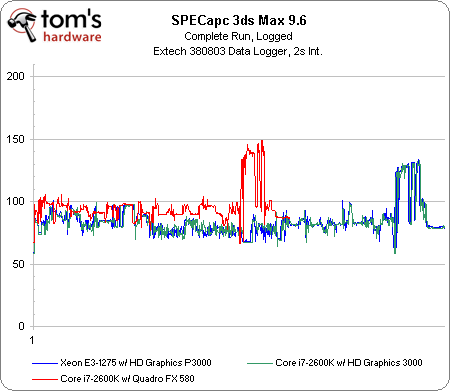Intel Xeon E3-1275 Review: Sandy Bridge Goes Professional
We've already seen Sandy Bridge impress in the desktop space. Does Intel's latest processor architecture have what it takes to dominate the single-socket server and workstation space, too? We run the fastest workstation SKU through our benchmark suite.
Power Consumption
Measuring power in a story like this is never going to be an exercise in precision. If you run a processor-limited test, graphics get ignored. A graphics-heavy benchmark might overemphasize the GPU at the expense of the rest of the platform.
Logging the SPECapc 3ds Max 9 benchmark seemed like a good compromise, though. Not only does the test have its own CPU render component to complement the graphics tests, but it also seemed to show Intel’s HD Graphics P3000/3000 engine in a fairly balanced light.
What the SPECapc score doesn’t tell you is how much faster the Quadro FX 580 wraps this test up. The entire thing takes just over 15 minutes with discrete graphics. It takes more than 25 minutes on either the Xeon E3 or Core i7 platforms using Intel’s processor graphics.
If you flatten each of those three lines, you discover that both systems with Intel CPUs and Intel graphics average about 84 W over the course of the run. Dropping the add-in card increases average system power use to nearly 96 W (that’s not bad, by the way, though it suggests only moderate utilization of the GPU).
Unfortunately, those averages mean very little, aside from the fact that adding a graphics cards increases power use (duh). You have to multiply them by the fraction of an hour it takes the workload to complete. Do that and the story turns around. Because the Intel systems take so long to finish their job, they use more than 35 watt-hours. Adding the discrete card, however, drops that figure to 25 watt-hours.
Now, I’m not trying to say a workstation with a Xeon and a Quadro card in it is going to reflect that power graph for everyone. Many, many professional workloads are exclusively processor-bound. Dumping an add-in board is only going to increase power consumption. Log a run through Premiere Pro CS5, for example, and the Nvidia chip will spin idle, unused.
So really, our figures are most useful for, one, showing that the Xeon E3-1275 has the exact same power profile as a Core i7-2600K and two, demonstrating that although an all-integrated solution is more power-friendly at any given point in time, it can also drag its feet to the point where adding discrete graphics would actually be more power-friendly in a given workload.
Get Tom's Hardware's best news and in-depth reviews, straight to your inbox.
-
dragonsqrrl one-shotStop teasing and give us a six core Sandy Bridge CPU!Sandy Bridge-E, LGA 2011 X79, Q4 2011.Reply -
agnickolov Finally a compilation benchmark! Now please make it standard in your test suite for CPUs and storage so there's a real benefit from it all for actual comparisons.Reply -
DavC Thanks for this review Chris, very well covered. I'll probably be refering back to this when it comes to spec our next workstations.Reply -
I think this is a useless review. Why are we comparing Apples to Oranges? Lets compare current generation Xeons to Previous generation Xeons.Reply
-
dgingeri one thing I can attest to: companies who cheap out on their workstations and servers never perform well as companies, and eventually fail.Reply
I've worked with many small businesses, and every one that used a desktop chip for a server or a discount chip (Celeron, Duron, etc) for their desktop computers all performed very poorly. Some seemed to hang on by the sheer will of the owner, and in a couple cases, when the owner got sick for more than a week, the businesses folded like lawn chairs.
I've also seen an Engineering shop of ~30 engineers invest nicely into a real server and real workstations, and had me set up their entire network with SBS. their business ramped up so fast and well that they had to hire several more engineers and outgrew SBS (limited to 50 users at the time) within the next 2 years, and I had to go back and rebuild their domain with full enterprise level software, and add another server specifically for email. the owner said the investment in that SBS system was the best thing he'd invested in the business since he hired his first engineer.
Business owners who do not invest in their IT infrastructure fail at business. It's pretty plain and simple. While investing in good IT gear and software doesn't mean you'll ramp up your business to unheard of heights, it does give you a major leg up on the competition. -
given the option of a cheaper Xenon that does not have the P3000 im pretty sure 90% of companies would choose that option, discreet graphics would almost exclusively be employed for the majority of workstation class desktopsReply

